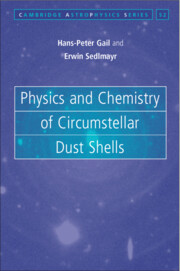Book contents
- Frontmatter
- Contents
- Preface
- Part I Setting the Stage
- Part II Theoretical Description of Circumstellar Dust Shells
- 3 Theory of Circumstellar Dust Shells
- 4 Energy Equation for Matter
- 5 Radiative Transfer
- 6 Interaction between Gas and Dust Particles
- 7 Extinction by Dust Grains
- 8 Approaches to the Temperature Equations
- 9 Chemistry in Thermodynamic Equilibrium
- 10 Gas-Phase Chemical Composition
- 11 Gas-Solid Chemical Equilibria
- 12 Growth of Dust Grains
- 13 Formation of Seed Nuclei
- 14 Moment Equations
- Part III Applications
- Part IV Appendices
- Bibliography
- Index
- Miscellaneous Endmatter
6 - Interaction between Gas and Dust Particles
from Part II - Theoretical Description of Circumstellar Dust Shells
Published online by Cambridge University Press: 18 December 2013
- Frontmatter
- Contents
- Preface
- Part I Setting the Stage
- Part II Theoretical Description of Circumstellar Dust Shells
- 3 Theory of Circumstellar Dust Shells
- 4 Energy Equation for Matter
- 5 Radiative Transfer
- 6 Interaction between Gas and Dust Particles
- 7 Extinction by Dust Grains
- 8 Approaches to the Temperature Equations
- 9 Chemistry in Thermodynamic Equilibrium
- 10 Gas-Phase Chemical Composition
- 11 Gas-Solid Chemical Equilibria
- 12 Growth of Dust Grains
- 13 Formation of Seed Nuclei
- 14 Moment Equations
- Part III Applications
- Part IV Appendices
- Bibliography
- Index
- Miscellaneous Endmatter
Summary
The matter in circumstellar dust shells is a multicomponent mixture of various different gases with a small admixture of about 1 percent (by mass) of tiny solid particulates – the dust component of the circumstellar matter – which itself is a mixture of a number of condensed mineral phases that form particles of different sizes and shapes. The more formal aspects of the description of such a multicomponent mixture were discussed in Section 3.1. Now the details of the dynamic and thermal interaction between the different components are discussed, which will result in a specification of the corresponding terms in the general equations for the description of a gas-dust mixture and in identifying the important processes that have to be considered in models of circumstellar dust shells.
The most basic interaction processes in a mixture of gases are the permanent mutual collisions between the particles. These collisions result in an exchange of matter, momentum, and energy between the components of the mixture. In some cases they also result in chemical reactions that change the number densities of the components involved in the reactions. The most important process with respect to the stellar wind problem is the momentum exchange by collisions between particles from the different components that results in a very strong, dynamic coupling between the gaseous components and a close but not so strong dynamic coupling between the dust and gas components.
Information
- Type
- Chapter
- Information
- Physics and Chemistry of Circumstellar Dust Shells , pp. 130 - 166Publisher: Cambridge University PressPrint publication year: 2013
